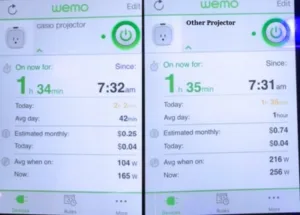In the early years of mass projector purchasing by schools and universities (I have floated some very large tenders myself), the key “look for” was brightness or lumens. That made particular sense in K-12 (primary & secondary schooling), because most classrooms were built with no understanding of projectors in mind.

![]() School architects built classrooms with lots of natural light; they deliberately placed lighting fixtures in front of whiteboards (and screens); and deployed lighting systems that would not permit area dimming—classroom lighting is usually all on or all off. So lumens mattered. To teachers. And so the marketing machine hummed.
School architects built classrooms with lots of natural light; they deliberately placed lighting fixtures in front of whiteboards (and screens); and deployed lighting systems that would not permit area dimming—classroom lighting is usually all on or all off. So lumens mattered. To teachers. And so the marketing machine hummed.
Then the esteemed true color “look for” arrived. Projectors were marketed to schools based on their ability to represent colors accurately. This made more sense to science faculty, art faculty, and school techies, but most teachers didn’t really care. Nevertheless, the marketing genie whisked the education market along for a magic carpet ride.
Along came the control, flexibility, and connectivity meme. This “look for” was the IT professional’s paradise: multi-port availability to accommodate the individual technical tastes of institutions; networkability for remote management; and wireless or wired infrastructure for seamless image delivery. The premise was to reduce TCO (total cost of ownership)—but mostly, for the benefit of, often lean, IT support teams.
More recently, momentum has been gathering for the picture quality “look for.” Just a brief moment of silence for VGA as the move to XGA, 1080p, WXGA, and other standards lunged forward. Except for science faculty and universities, most faculty didn’t care.
Then at InfoComm 2016, I saw a refreshing twist: a booth that voiced what teachers really want from projectors these days. I was pleasantly surprised to see a featured area in the large Casio booth that spoke exceptionally well to faculty—the ground troops of education—the teachers. Casio, which has had a surprisingly steady presence at U.S. educational conferences, carried three very strong messages.
Three Strong Messages
The first spoke to the truest form of return on investment (ROI) in schools: instructional time. At one station, the signage announced the“Instant On / Instant Off” capabilities of their projectors. Booth visitors could turn off two projectors (one a Casio, the other a competitor’s projector) and compare how fast they turn off and turn back on again. The comparison was stark. This simple demonstration spoke to the most important type of ROI—reclaiming instructional minutes. A projector, when left on, can provide a bumble bee moment for easily distracted children. But the ability to instantly turn off a projector, and instantly restart it when needed, reclaims a good deal of instructional time that might ordinarily be wasted. (In can take five minutes at our university for a projector to warm up.)
The second message addressed the chief pain points of classroom teachers: how long will this projector last? And how long will the projector lamp last before an expensive bulb replacement is required? This second station touted the lamp-free feature of the Casio projectors. (Teachers have been known to wait for months before a simple lamp purchase is approved by their principal—while the projector goes unused.) This second station also evidenced how long the projector would last before requiring physical replacement. The projector being used had nearly 20,000 hours on it, and was still going strong—without even a replacement bulb or standard projection yellowing or degradation. That’s at least 6 years of instructional use before replacement. (Schools budgets are quite unforgiving when replacing legacy equipment: replacement schedules are frequently pushed back several years.)
The third station carried a message that is important to many teachers these days: being mindful of energy consumption (which is also a TCO concern for school building electrical budgets.) Side by side, two projectors in the booth evidenced the cost savings of the Casio brand over time, as compared with Brand X. See the chart below, showing the results of both projectors (I stitched them together):
 Can you imagine triple the energy cost with Brand X projector?
Can you imagine triple the energy cost with Brand X projector?
These are important issues for K-12 classrooms, schools, and districts, which we know are not flush with money these days. In this case, Casio carried the strongest message of the many projector company booths I visited at InfoComm 2016. It was a message directly to teachers. Now you know what teachers really want.
– Len Scrogan

